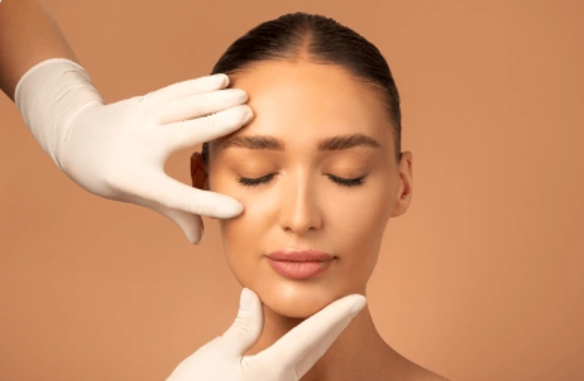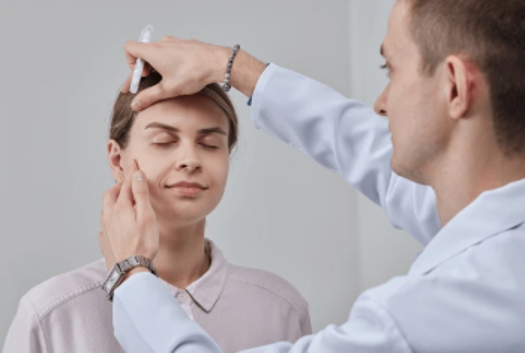They say the eyes are the window to the soul, but what if yours are telling a story of fatigue, stress, or premature aging that doesn’t reflect how you truly feel? The delicate skin around our eyes is one of the first areas to show signs of aging.
From puffiness and sagging to under-eye bags and drooping lids, these common concerns can make us look older, tired, or even obstruct our vision. Thankfully, blepharoplasty (blef-uh-roe-plas-tee), an effective eyelid surgery, offers a powerful way to turn back the clock.
Whether you’re concerned about aesthetics, functionality, or both, upper and lower blepharoplasty can subtly but significantly enhance your appearance. In this blog, we’ll explore the causes of aging around the eyes, break down what a blepharoplasty entails, and explain why Howerton Eye is a trusted name in eye care and this surgery.
If you are considering a blepharoplasty in Austin, Texas, Howerton Eye Center might be the place for you!
What Causes Aging Around the Eyes?
The eye area is uniquely vulnerable to aging due to its thin, sensitive skin and constant movement. Several factors contribute to visible changes:
- Loss of collagen and elasticity: As we age, the skin naturally loses firmness and volume, leading to sagging and wrinkles.
- Fat redistribution: Fat pads around the eyes can shift, creating puffiness or hollowing.
- Sun exposure: UV rays accelerate aging and contribute to pigmentation and texture changes.
- Genetics: Your family history can influence how early and how dramatically aging appears around your eyes.
- Lifestyle factors: Smoking, stress, lack of sleep, and poor nutrition can worse the signs of aging.
Over time, these changes may not only impact how we look but how we see, particularly if excess skin begins to interfere with vision.
What is a Blepharoplasty?
Blepharoplasty is a surgical procedure that corrects excess skin, muscle, and fat around the eyelids. There are two types:
- Upper blepharoplasty: Focusing on removing sagging skin and fatty deposits from the upper eyelids. It’s often performed to improve vision and create a more alert, youthful appearance.
- Lower blepharoplasty: Targets puffiness, under-eye bags, and skin laxity below the eyes, creating smoother contours and reducing the appearance of tiredness.
Blepharoplasty can be performed for cosmetic reasons, functional reasons, or both. It’s a nuanced surgery that requires precision, experience, and a deep understanding of both eye anatomy and facial aesthetics, which the surgeons at Howerton Eye Center in Austin Texas are very familiar with.

What is the Blepharoplasty Process?
1. Consultation
Your journey begins with an in-depth conversation with our surgeon. We evaluate your medical history, discuss your goals, and perform a physical examination of your eyes and surrounding tissues. Advanced imaging may also be used to assess eyelid structure and determine if any vision interference exists.
We’ll determine whether you need upper, lower, or a combination of both blepharoplasties and explain the expected benefits, risks, and outcomes.
2. Pre-Operative Prep
Once surgery is scheduled, you’ll receive specific instructions to prepare, including which medications to avoid and how to arrange transportation and post-op care. You may be asked to stop smoking and limit alcohol to promote healing.
3. The Procedure
Blepharoplasty is typically performed on an eyelid using local anesthesia with sedation or general anesthesia, depending on your preferences and surgical plan.
- For upper blepharoplasty, an incision is made in the natural crease of the upper eyelid to remove excess skin, fat, and sometimes muscle.
- For lower blepharoplasty, the incision may be made just below the lash line or inside the lower eyelid (transconjunctival approach) to reposition or remove fat and tighten skin.
The procedure usually takes 1–2 hours depending on the extent and whether both upper and lower lids are treated.
Realistic Recovery: What You Need to Know
Recovery after blepharoplasty is generally smooth, but knowing what to expect makes the process even easier:
- Swelling and bruising: This is the most prominent during the first 5-7 days and can be managed with cold compresses and head elevation.
- Sutures and follow-ups: Stitches are often removed within 5-7 days. We’ll guide you through every follow-up to ensure proper healing.
- Activity: Most patients return to light activities within a week, but strenuous exercise and heavy lifting should be avoided for 2-3 weeks.
- Final results: While initial improvements are noticeable as swelling subsides, it make take a few months for all subtle swelling to resolve and for scars to fade.
You’ll be given detailed instructions and personal support every step of the way, so you feel confident and comfortable during recovery.
What Results Can You Expect?
Blepharoplasty results are often described as “refreshed” or “rested” rather than drastically altered. It is important to go into this procedure with realistic expectations.
Most patients experience:
- A brighter, more youthful appearance
- Reduced puffiness and eye bags
- A smoother transition between the lower eyelid and cheek
- Improved symmetry between eyes
- Enhanced vision in cases where sagging skin blocked sight
It’s essential to understand that blepharoplasty is not a facelift—nor is it designed to change your fundamental appearance. It won’t lift your cheeks, erase deep wrinkles, or dramatically alter your face. Instead, blepharoplasty focuses on refreshing the eye area, helping you look more awake, rested, and subtly rejuvenated.
Results are long-lasting, typically 7-10 years or more, especially when paired with good skin care and sun protection. Because the changes are subtle and natural, friends and colleagues may not realize you’ve had surgery, just that you look well-rested and rejuvenated.
Blepharoplasty vs. Botox or Fillers: Understanding the Difference
With so many non-surgical cosmetic treatments on the market, it’s natural to wonder: Why choose surgery when injectables like Botox or fillers are so accessible?
While Botox and dermal fillers certainly have their place in facial rejuvenation, they serve a very different purpose than blepharoplasty. The key difference lies in what is being treated and how long the results last.
- Botox works by temporarily relaxing muscles to smooth fine lines and wrinkles—particularly crow’s feet around the outer eyes. It’s ideal for dynamic wrinkles caused by expression but doesn’t address sagging skin or under-eye bags.
- Dermal fillers restore volume to hollow or sunken areas, often used in the tear troughs or midface. They can soften the transition between the lower eyelid and the cheek, but they can’t remove excess skin or fat.
Blepharoplasty, on the other hand, is a surgical solution for structural issues. It removes or repositions fat, trims away loose or sagging skin, and tightens muscles as needed. The results are long-lasting—often a decade or more—and far more effective at correcting significant eyelid aging.
Confidence Beyond the Mirror
While the physical transformation is significant, many patients report an equally meaningful emotional shift. Restoring the natural vibrancy of your eyes can:
- Enhance confidence in social and professional settings
- Eliminate the disconnect between how you look and how you feel
- Boost self-esteem without changing your core identity
- Help you feel “seen” again, without distraction from puffiness or droopiness
Looking in the mirror and seeing a more alert, youthful version of yourself can have a profound psychological effect.

Is This The Right Procedure For You?
Blepharoplasty may be right for you if you:
- Are bothered by sagging, drooping, or puffy eyelids
- Have excess skin that affects your vision
- Are in overall good health and free of conditions that impair healing
- Do not smoke or are willing to quit prior to surgery
- Have realistic expectations about the results
Whether you’re 38 or 68, this procedure is highly customizable and age-inclusive. The best way to find out if you’re a candidate is to schedule a consultation with our team at Howerton Eye Center.
Will Insurance Cover my Blepharoplasty?
One of the most common questions we hear is: “Will insurance cover this procedure?” The answer is: it depends on the reason for your surgery.
If your upper eyelids are drooping enough to impair your vision, causing you to strain your forehead muscles, tilt your head back, or struggle with peripheral vision, then insurance may cover your upper blepharoplasty as a medically necessary procedure.
To determine this, we’ll perform:
- A comprehensive eye exam
- A visual field test (also known as a “visual field obstruction test”) to objectively measure whether the skin impairs your sight
- Clinical Photography and documentation required for pre-authorization
If approved, your insurance provider may cover part or all of the cost related to functional correctionof the upper lids.
However, lower blepharoplasty, and upper eyelid surgery done purely for cosmetic reasons, is usually not covered by insurance and is considered an out-of-pocket expense.
At Howerton Eye, our experienced team can help navigate the insurance approval process and provide clear, upfront information about costs. Whether your goals are medical, cosmetic, or both, we’re here to ensure you feel informed, empowered, and supported every step of the way.
Why Trust Howerton with Your Eyes?
At Howerton Eye Center located in Austin, Texas, your vision and confidence are our top priorities. As leaders in comprehensive eye care, we offer:
- Board-certified expertise: Our surgeons are specially trained in ophthalmology, bringing a unique combination of functional and aesthetic insight.
- State-of-the-art technology: From diagnostics to surgical tools, we use the latest techniques to ensure precision, safety, and comfort.
- Patient-first care: We take the time to listen, answer your questions, and customize a plan that’s right for you.
- Track record of trust: With thousands of successful procedures and glowing patient feedback since the 1970’s, we are known throughout Central Texas for excellence in care.
Because the eyes are such delicate and important features, blepharoplasty should never be taken lightly. That’s why choosing an experienced, ophthalmology-based practice like Howerton Eye Center gives you peace of mind, not just for how you’ll look, but for how you’ll see. If you’re looking for any information on getting a blepharoplasty in Austin, Texas, schedule an appointment with us today.
Final Thoughts
Blepharoplasty is more than just a cosmetic procedure, it’s a meaningful step toward feeling like your most vibrant self again. Whether you’re battling sagging eyelids that affect your vision or simply want to restore youthful brightness to your gaze, upper and lower eyelid surgery can deliver transformative results with subtle elegance.
At Howerton Eye Center in Austin Texas, we’re proud to offer this life-enhancing procedure with unmatched skill, compassion, and attention to detail. If you’ve been curious about eyelid surgery in Austin, Texas, now is the time to explore your options and turn back the clock, with confidence.
Schedule your consultation today and discover how blepharoplasty can rejuvenate your eyes and renew your outlook.
*Note: This article is for informational purposes only and should not replace professional medical advice. Consult with a qualified eye care specialist for personalized recommendations.*
References
- Mayo Clinic
https://www.mayoclinic.org/tests-procedures/blepharoplasty/about/pac-20385174
- Cleveland Clinic
https://my.clevelandclinic.org/health/treatments/8409-eyelid-surgery-blepharoplasty
- American Academy of Ophthalmology
https://www.aao.org/eye-health/treatments/upper-eyelid-blepharoplasty
- Verywell Health
https://www.verywellhealth.com/blepharoplasty-eyelid-surgery-2710040


